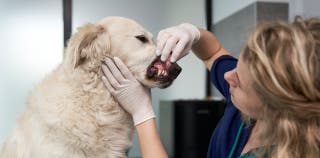How much does dog cataract surgery cost?
On average, surgery to correct cataracts in dogs may cost between $2,500 and $5,000 total. No one type of surgery corrects all types of canine cataracts, so the cost depends on the procedure is required.
Factors that determine the cost of cataract surgery for dogs
A variety of factors impact the cost of canine cataract surgery:
-
Type of surgery: Some surgeries may be more expensive than others, so talk to your veterinarian about your options and what might be right for your pet.
-
Condition of the eye: The severity of the cataracts and the overall health of the eye impact the work required by canine eye specialists in surgery. This can affect the cost of the procedure.
-
Geographic location: Veterinary care, including surgery, costs more in some states and cities than in others.
-
Number of eyes: Whether just one or both eyes require surgery also impacts the cost of the procedure.
What’s included in the cost of cataract surgery?
Various vet offices, clinics and animal hospitals charge differently. However, it’s common for the original exam, diagnostic tests, general anesthesia and actual procedure to be included in the costs described above. A follow-up checkup may also be included.
What’s not included in the cost?
In some cases, the preliminary examination, ocular ultrasound, required medications and even anesthesia may be billed separately. Always talk to your vet to ensure you understand the costs of your cataract surgery bill and what may be charged separately.
If you haven’t set aside an emergency fund for your dog’s cataract surgery, it’s worth comparing the cost of pet insurance versus the surgery. The insurance policy may cover the surgery, potentially saving you thousands of dollars.
What are cataracts in dogs?
The lens over a healthy dog’s eye is transparent. When dogs develop cataracts, the lens becomes cloudy.
As a condition, cataracts are typically progressive. If pets don’t receive treatment for this condition, it can worsen over time, negatively impacting a dog’s vision to the point it cannot see.
Cataracts shouldn’t be confused with other eye conditions that can impact dogs, which include:
-
Glaucoma: This condition involves pressure in the eye and may lead to a cloudy appearance on the eye. Treatments for glaucoma in dogs are not as successful as treatments for cataracts.
-
Retinal detachment: This occurs when a layer of cells at the back of the eye is detached and loose. It can cause partial or total blindness. Some retinal detachments are treatable.
-
Nuclear sclerosis: This is a blue-white tint to a dog’s eye that can occur with age. It doesn’t impact your dog’s vision and probably won’t require treatment.
What are the signs of cataracts in dogs?
Common signs of cataracts in dogs include:
- Sudden and otherwise unexplained layers in the eye may be white, blue or gray.
- Clumsiness or other signs your dog doesn’t see as well as it used to.
- Discharge, blinking, redness or other signs of irritation in the eyes.
- Your dog rubs their eyes more than usual.
What are the causes of cataracts in dogs?
The potential causes of cataracts in dogs include:
-
Genetics: Some dog breeds are more likely to suffer from cataracts than others. Dogs can also have hereditary cataracts, impacting them at any age.
-
Age: Over the course of a dog’s lifespan, they are more susceptible to health issues, including cataracts, as they get older.
-
Congenital disabilities: Dogs born with congenital disabilities that cause cataracts may have them at birth.
-
Diabetes: Diabetes increases a dog’s risk of cataracts substantially.
Can you prevent cataracts in dogs?
You can’t always prevent cataracts in your dog. However, regular veterinary care and paying attention to your dog’s health can reduce the risks associated with developing cataracts.
This is especially true if your dog has diabetes mellitus. Check its eyes often and take it to regular vet checkups to ensure its vision is healthy.
Some of the best pet insurance plans offer wellness coverage, which includes exam fees and routine care. In this case, pet insurance is worth having so you can monitor your dog’s health and catch any ailments quickly.
Alternatively, you can also take steps such as ensuring an anti-inflammatory diet and the right amount of exercise. While these steps may not prevent cataracts in your dog, they can improve its overall health.
Which dog breeds are susceptible to cataracts?
Some dogs are more genetically inclined to cataracts than others.
These breeds are more likely to get cataracts than others:
- Smooth Fox Terrier
- Havanese
- Bichon Frise
- Boston Terrier
- Miniature Poodle
- Silky Terrier
- Toy Poodle
- American Cocker Spaniel
- Poodle
- Miniature Schnauzer
However, any dog of any breed can develop cataracts.
How does cataract surgery work?
How a canine cataract surgery works depends on the type of surgery. A phacoemulsification, for example, uses ultrasound energy to break up the cloudy part of the lens and remove it.
What is the process for cataract surgery in dogs?
If a vet determines that your dog has this condition and is a good candidate for surgery, your dog will go through several steps.
A few common steps involved in cataract surgery for dogs include:
-
Pre-surgical testing: Preoperative testing consists of an ultrasound to ensure there are no other issues with the retina and that the procedure can move forward as planned.
-
Surgical procedure: The surgery is performed while your dog is under anesthesia. Once the damaged lens is removed, an artificial lens is implanted. It’s also called an intraocular lens, or IOL.
-
Post-surgery procedures: Your pet may need to remain in the animal hospital or at the vet office overnight to monitor issues like inflammation, potential infection and overall response to the surgery.
Once you go home with your pet, you will likely have to apply eye drops and may need to give oral medications for a while. Careful aftercare can help guarantee the long-term success of the surgery.
For most dogs, post-operative recovery time is about two weeks. During this period, dogs typically have to wear an e-collar or cone to prevent them from damaging the surgery site. You will also have to limit your dog’s exercise regimen to careful walks on a leash.
Will my dog be able to see after cataract surgery?
After the two-week recovery period, your dog’s vision will likely have significantly improved. Cataract surgeries for dogs are 80% to 90% successful, which means there’s a good chance your dog will regain all or most of their sight.
What are the risks of dog cataract surgery?
Pre-surgery, make sure you discuss the risks of the procedure with your vet. While complications are relatively rare with these types of procedures, they do exist.
Some potential risks of cataract surgery in dogs include:
- Corneal ulcers
- Increased pressure in the eyes
- Little or no improvement in vision
Does pet insurance cover the cost of cataract surgery for dogs?
Your pet insurance may cover cataract surgery for your dog.
This is a common benefit of comprehensive coverage plans for dogs, but you should check your benefits documents to be sure. Note that pet insurance doesn’t typically cover pre-existing conditions, however. If your dog already has cataracts, you probably can’t buy a pet insurance policy to cover the surgery.
For more information, look at our guide to pet insurance for pre-existing conditions.
Is dog cataract surgery worth the cost?
Depending on the severity of the cataract, your dog’s age and other factors, this surgery may be worth the cost. This is especially true if your pet insurance coverage includes cataract surgery and, therefore, significantly reduces your out-of-pocket expense.
Because cataract surgery in dogs has a success rate of up to 90%, you may find that your dog’s vision and quality of life are greatly improved by this procedure.
































